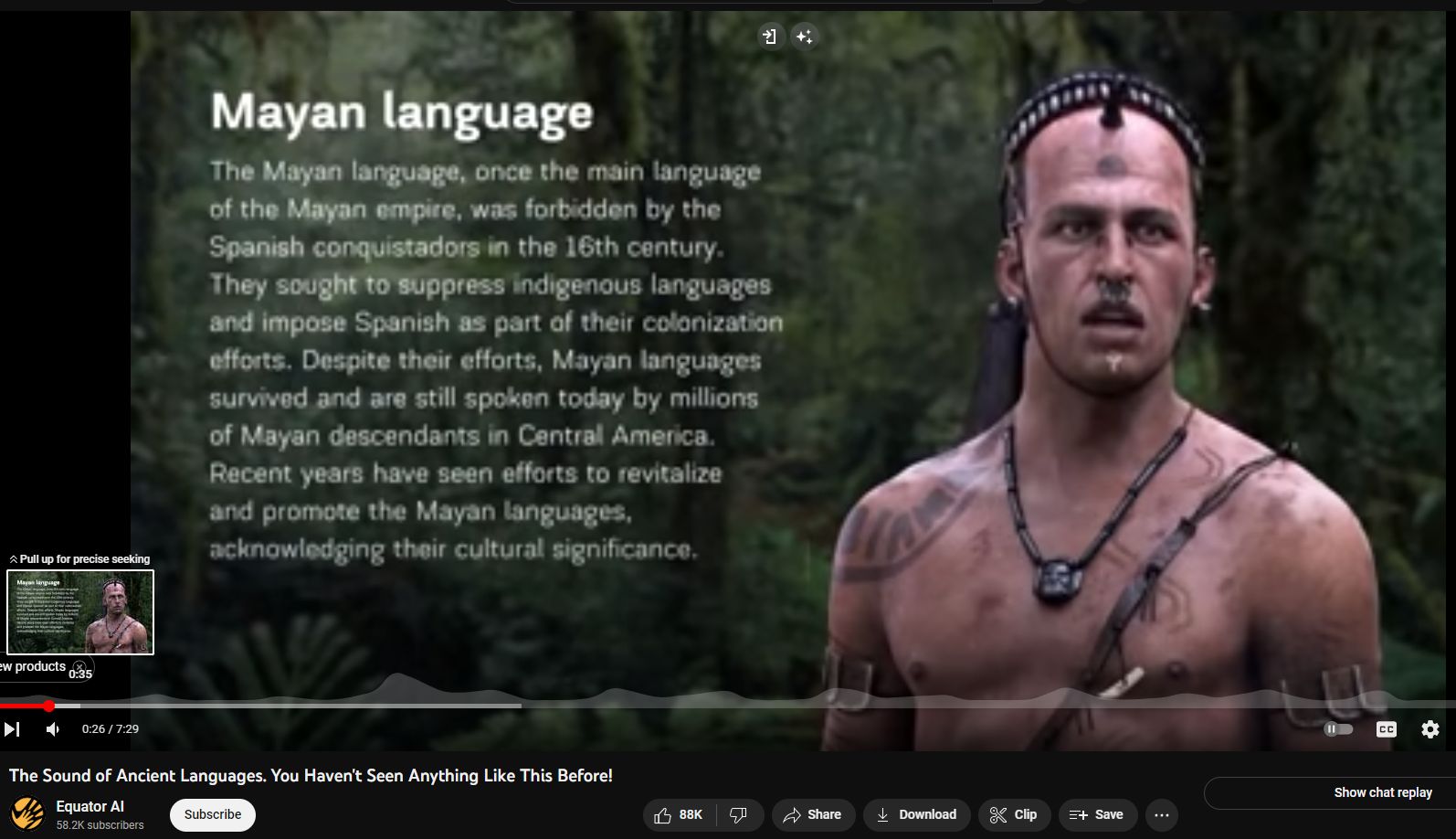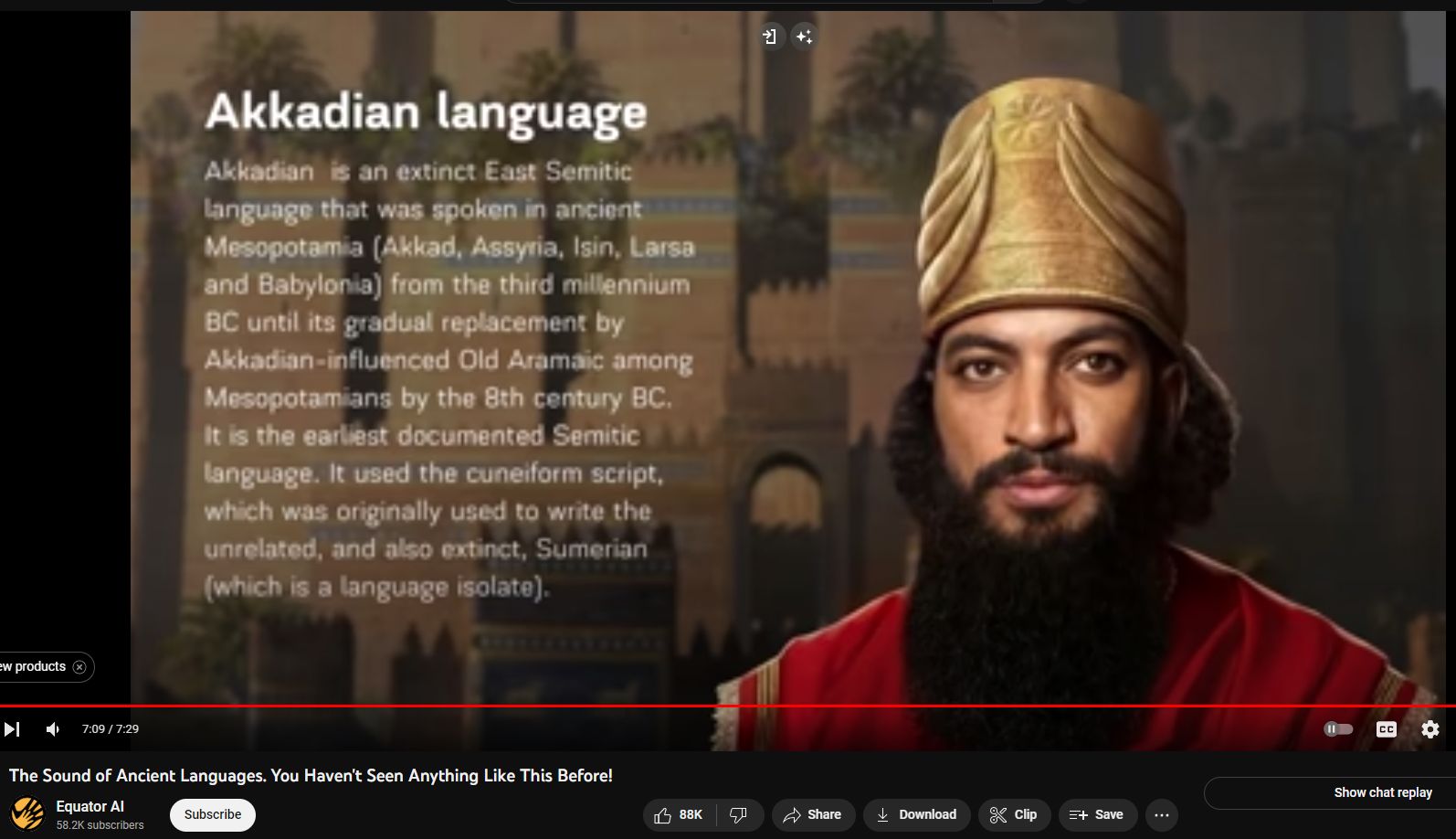The Sound of Ancient Languages
Old Norse – Old Nordic, Old Scandinavian, is a stage of development of North Germanic dialects before their final divergence into separate Nordic languages. Old Norse was spoken by inhabitants of Scandinavia and their overseas settlements and chronologically coincides with the Viking Age.
Mayan – Once the main language of the Mayan empire, it was forbitted by the Spanish conquistadors in the 16th century. They sought to suppress indigenous languages and impose Spanish as prt of their colonization efforts. Mayan languages survived and are still spoken today by millions of Mayan descendents in Central America. Recent years have seen efforts to revitalize and promote the Mayaln languages, acknowledging their cultural significance.
Latin – Language of ancient Romans, Roman Empire, the Latino-Faliscan branch of the Italic languages of the Indo-European language family. To date, it is the only active, albeit limitedly used, of the ancient Italic languages. The modern descendents of Latin are the Romance languages, while the other Italic languages disappeared without leaving descendants.
Middle Chinese – Formerly known as Ancient Chinese or the Qieyun system (QYS) is the historical variety of Chinese recorded in the Qieyun, a rhyme dictionary first published in 601 and followed by several revised and expanded editions. The Swedish linguist Bernard Karlgren believed that the dictionary recorded a speech stand of the capital Chang’an of the Sui and Tang dynasties.
Old English – or Anglo-Saxon, is the earliest recorded form of the English language, spoken in England and southern and eastern Scotland in the early Middle Ages [regarding the supposed Middle Ages, mathemtically/statistically evidenced by Anatoly Fomenko to be a complete fabrication / literal “stretch of time” — see also the Scaligerian time hoax]. It developed from the languages brought to Great Britain by Anglo-Saxon settlers in the mid 5th century, and the first Old English literary works date form the mid 7th century.
Old Japanese – The oldest attested stage of Japanese language, recorded in documents from the Nara period (8th century). It became Early Middle Japanese in the successding Heian period, but the precise delineation of the stages is controversial. Old Japanese was an early member of the Japnic language family. No genetic links to other langauges families have been proven.
Old Church Slavonic – or Old Slavonic was the first Slavic literary language. Historians credit the 9th century Byzantine missionaries Saints Cyril and Methodius with standardizing the language and using it in translating the Bible and other Ancient Greek ecclesiastical texts as part of the Christianization of the Slavs. It is thought to have been based primarily on the dialect of the 9th century Byzantine Slavs living in the Province of Thessalonica.
Proto-Celtic – or Common Celtic, the ancestral proto-language of all known Celtic languages, a descendent of Proto-European. It is not attested in writing but has been partly reconstructed through the comparative method. Proto-Celtic is generally thought to have been spoken between 1300 and 800 BC, after which it began to split into different languages.
Middle Egyptian – Middle Egyptian was spoken for about 700 years, beginning around 2000 BC, during the Middle Kingdown and subsequent Second Intermediate Period. As the classical variant of Egyptian, Middle Egyptian is the best-documented variety of the language, and it has attraced the most attention by far from Egyptology. Whilst most Middle Egyptian is seen written on monuments by hieroglyphs, it was also written using a cursive variant, and the related hieratic.
Ryukyuan – The language branch of the Ryukyu Islands in the East China Sea. According to one version, it is a dialect of the Japanese language. According to another, it comes from the Altaic language family. Time of separation: 7th century AD.
Ancient Greek – Includes the forms of the Greek language used in ancient Greece and the ancient world from around 1500 BC to 300 BC. It is often roughly divided into the following periods: Mycenaean Greek (c 1400-1200 BC), Dark Ages (c 1200-800 BC), the Archaic period (c 800-500 BC), and the Classical period (c 500-300 BC).
Phoenician – an extinct Canaanite Semitic language originally spoken in the region surrounding the cities of Tyre and Sidon. Extensive Tyro-Sidonian trade and commercial dominance led to Phoenician becoming a lingua-franca of the maritime Mediterranean during the Iron Age. The Phoenician alphabet spread to Greece during this period, where it became the source of all modern European scripts.
Hittite – An extinct Indo-European languages that was spoken by the Hitties, a people of Bronze Age Anatolia who created an empire centered on Hattusa, as well as parts of the northern Levant and Upper Mesopotamia. The language, now long extinct, is attested in cuneiform, in records dating from the 17th (Anitta text) to the 13th centuries BCE, with isolated Hittite loanwords and numerous personal names appearing in an Old Assyrian context from as early as the 20th century BCE, making it the earliest-attested use of the Indo-European languages.
Quechua – the main language family of the Inca Empire. The Spanish encouraged its use until the Peruvian struggle for Independence of the 1780s. As a result, Quechua variants are still widely spoken today, being the co-official language of many regions and the second-most spoken language family in Peru.
Akkadian – the extinct East Semitic language that was spoken in ancient Mesopotamia (Akkad, Assyria, Isin, Larse and Babylonia) from the third millenium BC until its gradual replacement by Akkadian-influenced Old Aramaic among Mesopotamians by the 8th century BC. It is the earliest documented Semitic language. It used the cuneiform script, which was originally used to write the unrelated and also extinct Sumerian (which is a language isolate).
“Immerse yourself in the mesmerizing world of ancient languages with our captivating video. Experience the enchanting sounds of bygone civilizations as realistic characters bring them to life. Journey through time as you listen to the melodic tones of forgotten tongues, each carefully researched and expertly voiced. From the mysterious cadence of Egyptian hieroglyphics to the lyrical beauty of Latin, let the echoes of the past transport you to a realm of linguistic wonder. Discover the linguistic heritage of our ancestors and witness the power of language in preserving the legacy of ancient civilizations. Prepare to be captivated as history’s forgotten voices resound once more.”
PART 2 — https://www.youtube.com/watch?v=wC0UG-Oq_90


===
The sound of ancient languages is a topic of great interest to linguists, historians, and language enthusiasts alike. While it is impossible to precisely recreate the exact sounds of ancient languages, scholars employ various techniques to infer and approximate their phonetic characteristics based on linguistic evidence, comparative analysis, and historical reconstructions. Here’s an overview of how ancient languages might have sounded:
1. Phonetic Reconstruction: Linguists use phonetic reconstruction to estimate the pronunciation of ancient languages by analyzing written records, linguistic features, and comparative evidence from related languages. By examining cognates (words with similar meanings and forms) in modern descendant languages, as well as comparative linguistic data, scholars can infer the phonetic inventory (sounds) of ancient languages.
2. Phonological Features: Ancient languages likely exhibited a range of phonological features, including consonants, vowels, tones, and prosody (rhythm and intonation). The specific phonetic characteristics of ancient languages varied depending on factors such as geographic location, linguistic family, and historical period.
3. Reconstructed Alphabets and Scripts: The decipherment of ancient writing systems, such as cuneiform, hieroglyphics, and Linear B, has provided valuable insights into the phonetic structure and pronunciation of ancient languages. By reconstructing the phonetic values of individual signs or characters, scholars can approximate the sounds of ancient texts and inscriptions.
4. Experimental Reconstruction: Some scholars conduct experimental reconstructions of ancient languages by applying linguistic principles and phonetic rules to reconstruct the pronunciation of specific words or phrases. This approach may involve using modern phonetic transcription systems, computer modeling, and comparative analysis to simulate the sound of ancient languages.
5. Artistic Interpretation: In popular culture and artistic representations, ancient languages are often portrayed using modern accents, dialects, or vocal styles to evoke a sense of authenticity or historical accuracy. While these interpretations may not accurately reflect the original sounds of ancient languages, they can provide a creative and immersive experience for audiences.
Overall, reconstructing the sound of ancient languages is a complex and interdisciplinary endeavor that draws on linguistic, historical, and archaeological evidence to approximate the phonetic characteristics of languages spoken millennia ago. While our understanding of ancient languages continues to evolve, ongoing research and scholarship contribute to our appreciation of the linguistic diversity and cultural heritage of past civilizations.